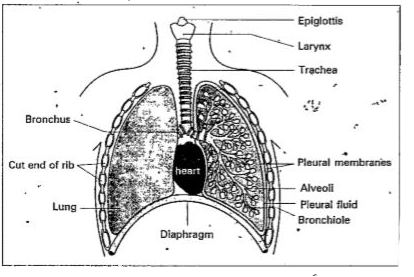In which part of the respiratory system of man , you can observe the 'C' shaped cartilagenous rings ?Solution in Telugu
The human respiratory system composed of external nostrils, nasal chambers, nasopharynx, larynx, trachea, bronchi, bronchioles and lungs. It is responsible for the process of respiration that is vital to the survival of living beings.
1) External nostrils : A pair of external nostrils opens out above the upper lip. They lead into pasal chambers through the nasal passages.
2) Nasal chambers : They lie above thepalateand are separated from each other by a nasal septum. Each nasal chamber can be differentiated into three.parts namely, i) Vestibular part - which has hair and sabaceous glands to prevent the entry of dust particles, ii) Respiratory part - involved in the conditioning the temperature, iii) Olfactory part - is lined, by an Olfactory epithelium.
3) Maso-pharynx -: Nasal chambers lead into nasopharynx through a pair of internal nostrils. Nasopharynx is a portion of pharynx, the common chamber for the passage of food and am Nasopharynx leads into oropharynx and opens through glottis of larynx into the frachea.
4) Lafynx: This is also called voice box or Adam.s apple, connects the pharynx with thetrachea. Larynx is the organ of voice as well as an air passage extending from the root of the tongue to the trachea. It is well developed in man. It consist.of a) Vocal cord b) Glottis c) Epiglottis.
a) Vocal cord : These are muscular folds that projects from lateral walls.
b) Glottis : Narrow passage between the true and false vocal cords of the larynx.
c) Epiglottis: It is a thin leaf like elastic cartilaginous flap attached to the thyroid cartilage to prevent the entry of food into the larynx through-the glottis.
5) Trachea : Trachea is also called windpipe. It is a straight tube extending upto the mid-thoracic cavity. The wall of the trachea is supported by 16-20 .C shaped rings of hyaline cartilage: These rings are incomplete dorsally and keep the trachea always.openpreventing collapse. Internally the trachea is lined by pseudostratified ciliated epithelium.
6) Bronchi and Bronchioles: On entering the mid thoracic cavity, trachea divides into right and left primary bronchi. Each primary bronchus enters the corresponding lung and divides into secondary bronchi that further divides into tertiary bronchi. Each tertiary bronchus divides and redivides to form primary, secondary, .tertiary, terminal and respiratory bronchioles. Each respiratory bronchiole terminates in a cluster of alveolar ducts which ends in alveolar sacs.
7) Lungs : These are paired, situated in the thoracic chamber which is anatomically an air tight chamber.. Lungs are covered by a doubled layered pleura with pleural fluid between them.- It reduces friction on the lung surface. The outer pleural membrane is in close contact with the thoracic lining where as the inner pleural membrane is in contact with lung.s surface. The part starting.with external nostrils upto the terminal bronchioles constitute the conducting part* whereas the alveoli and-their ducts form the respiratory "or exchange part of respiratory system. The conducting. part transports the atmospheric air to the alveoli, clears it fromforeign particles, humidifies and also bring the inhaled air to the body temperature. Exchange part »the site.6f actual diffusion of and between blood and atmospheric air.

Topper's Solved these Questions
- BREATHING AND EXCHANGE OF GASES Book:VIKRAM PUBLICATION ( ANDHRA PUBLICATION)Chapter:BREATHING AND EXCHANGE OF GASES Exercise:IMPORTANT QUESTIONS
Explore 6 Videos
- BREATHING AND EXCHANGE OF GASES Book:VIKRAM PUBLICATION ( ANDHRA PUBLICATION)Chapter:BREATHING AND EXCHANGE OF GASES Exercise:SHORT ANSWER QUESTIONS
Explore 5 Videos
- BODY FLUIDS AND CIRCULATION Book:VIKRAM PUBLICATION ( ANDHRA PUBLICATION)Chapter:BODY FLUIDS AND CIRCULATION Exercise:LONG ANSWER QUESTIONS
Explore 2 Videos
- DIGESTION AND ABSORPTION Book:VIKRAM PUBLICATION ( ANDHRA PUBLICATION)Chapter:DIGESTION AND ABSORPTION Exercise:IMPORTANT QUESTIONS
Explore 12 Videos
Similar Questions
Vital capacity does not include
View SolutionDistinguish between Inspiration and Expiration
View SolutionDescribe the structure of human lungs with the help of a diagram
View SolutionDental formula of adult humans is
View SolutionIncomplete cartilagenous rings are present upto_____
View Solutionनिम्नाकित कौन मानव श्वसन तंत्र का भाग नहीं है?
View SolutionWhere can you observe respiratory roots ?
View SolutionIn which part of the respiratory system of man , you can observe the 'C' shaped cartilagenous rings ?
View SolutionIn which animals we can observe tracheal respiratory system ?
View SolutionWhich structures are part of conducting portion of the respiratory system?
View SolutionExplain the disorders of the respiratory system of man.
View SolutionGive an account of respiratory system in man.
View SolutionWhich structures are part of the conducting portion of the respiratory system?
View SolutionWhich of the following is not a part of the human respiratory system?
View Solutionनिम्नाकित कौन मानव श्वसन तंत्र का भाग नहीं है?
View Solution
